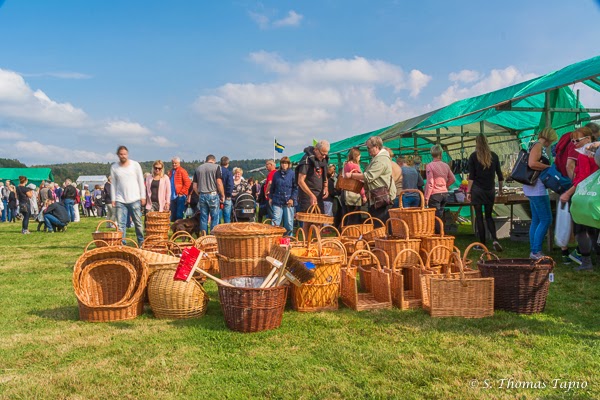Wanås Castle, Östra Göinge
Pictures taken over three days in connection with the visit from the Swedish Royal Family.
 |
| Overlooking the castle across the pond. |
Wanås Castle is situated in the green northeastern Skåne where wonderful beech forests light up the environment. Situated on the historic border between Denmark and Sweden it has a background as "Snapphane-region" in the 17th century. Today Wanås Castle is privately owned and on the grounds operate both Wanås estate and Wanås Art. Wanås Estate AB is active in forestry and agriculture, hunting and property management (www.wanas.se). Wanås Art display some 50 permanent works in the park with new entries from national and international artists annually. For more information visit our earlier blogpost or the Wanås website.
 |
| Left Wanås Art entrance and its exhibition halls and Wanås Estate in the background. |
HM Crown princess Victoria and HM Prince Daniel
On a full day visit, by invitation of the Göinge Trade and Industry, to Östra Göinge and Wanås.
 |
| Attentive of the Art Collection in the beech forest. |
Living very close to Wanås gives us the opportunity to visit the premises often for walks and photographic purposes. The exhibitions are interesting and the park, including the art work, beautiful to visit for an afternoon stroll. Earlier in the summer King Carl XVI Gustaf and Queen Silvia visited Kristianstad and now we had the opportunity to join the locals in welcoming Crown princess Victoria and Prins Daniel.
I arrived early enough at Wanås and entered with my fresh Season Card. Then spotted the waiting crowd and joined them. With my camera I am often mistaken for "The Press" so also this time, but I know to excuse myself as "The Public". This actually gives some advantages as I then can move freely and not being ushered in a strict manner like The Press has to cope with. Moving freely, with some polite guidance from "The Security" allows me to find good positions for photography like the picture above and the two below.
 |
| A Welcome Flower. |
The draw back can be that I may have difficulties knowing what way the guests are going to take and running alongside is not always possible. I may therefore find myself in the rear of the procession and overtaking it can be cumbersome. Below, by "The Wish Tree for Wanås" by Yoko Ono, we are doing just fine. Later in the woods I made a circumventive move in order to join "The Press". I found the perfect spot for myself but was soon surrounded by "The Press" and cameras where going off all over the place. I was asked who I was - ahaa, "The Public". Later I understood not to enter the Private areas of the Castle but instead let the professionals do their work.
 |
| By the "Wish Tree for Wanås" by Yoko Ono. |
Forest Surrounding Wanås
A few shots from the forests around Wanås. The below mushrooms caught my attention as they were way up on the tree. The below collage give some understanding of the colorful beech forest and the art works displayed there. The tree in the middle is called the Snapphane Oak that is about 500 years old. It played a role during the Snapphane Rebellion during the Swedish-Danish wars in the 17th century as some rebells are said to be hanged by their neck from this tree.
 |
| Mushrooming 10 meters up. |
 |
| Wanås Beech Forest and the Snapphane Oak in the middle. |
Wanås Art
Wanås is marketed as the place where "art, nature and history meet" and this is perfectly true. Mrs. T says that she (that means "we") have never seen anything like this before. From contemporary art Wanås has also moved into other visual arts like design, dance and architecture. They also publish books, organize seminars and activate thousands of children for educational purposes (www.wanas.se). Much attention is given to create an international profile for Wanås Art. A short presentation of only a few of all 50 permanent art works.
 |
| Embraced by Nature |
 |
| Presenting Wanås Art; Left "Wish Trees for Wanås" by Yoko Ono, top right "Two Different Anamorphic Surfaces" by Dan Graham and right middle "Whitney Outhouse of American Art" by Thom Merrick. |
 |
| Wanås Art; left "Wanås" by Per Kirkeby and right "Primary Structure" by Jacob Dahlgren. |
Spring 2014
Our first visit to Wanås took place in the spring of 2014 when we had moved to Östra Göinge. The below picture is unique in the sense that it no longer "exist" because of a sculpture placed here. The second picture reminds us of the fact that Wanås is very much also for the children.
 |
| Resting place by the pond early spring. |
 |
| A Childrens Wanås, too. |
Mrs. T and I hope that our readers find Wanås as intriguing as we do. The season is ending in October with opening hours during week-ends only. The "Sale" in their shop is on by the way. And they are organizing a photographic competition - quess who is participating?
Have a very good week-end and join us for Kivik Harvest Festival tomorrow, Saturday 27th.
:-)























































